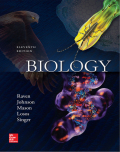
Concept explainers
A covalent bond between two atoms represents what kind of energy?
a. Kinetic energy
b. Potential energy
c. Mechanical energy
d. Solar energy
Introduction:
The covalent bond is formed by the sharing of one or more electron pairs between the two atoms. Usually, the two atoms involved in the covalent bond have either almost equal electro negativity or there is a large difference between the electro negativity. The formation of the covalent bond allows the atoms to achieve their stable configuration.
Answer to Problem 1U
Correct answer:
The covalent bond, which is formed between the two atoms, contains the potential energy. Therefore, option b is correct.
Explanation of Solution
Reasons for the correct statement:
The covalent bond is formed by the sharing of one or more electron pairs between the two atoms. The covalent bond stores a large amount of energy in the form of potential energy. It requires energy to break the bond.
Option b is given as "potential energy."
As the energy stored in the covalent bond is a form of potential energy, option b is the right answer.
Reasons for the incorrect statements:
Option a is given as “kinetic energy.”
The energy of motion is known as kinetic energy. So, it is a wrong answer.
Option c is given as “mechanical energy.”
The mechanical energy is the sum total of the kinetic and the potential energy. It is conjugated to the position and the motion of the object. So, it is a wrong answer.
Option d is given as “solar energy.”
The heat and the radiant energy obtained from the sun is termed as the solar energy. So, it is a wrong answer.
Hence, the options a, c, and d are incorrect.
The covalent bond stores energy in the form of potential energy. Energy is required to break the bond between two atoms.
Want to see more full solutions like this?
Chapter 6 Solutions
EBK BIOLOGY
- This occurs when the cations and anions are attracted to the positive and negative ends of water molecules: A. ionic bonding B. dissociation C. covalent bonding D. hydrogen bondingarrow_forwardWhat is activation energy? a. The thermal energy associated with random movements of molecules b. The energy released through breaking chemical bonds c. The difference in free energy between reactants and products d. The energy required to initiate a chemical reactionarrow_forwardSelect the statements that are TRUE regarding Water. SELECT ALL THAT APPLY A. Water is amphoteric B. Water can be a base C. Water is partially charged D. Water can be an acidarrow_forward
- A substance that has weight and occupies space is calleda. kinetic energy.b. a catalyst.c. matter.d. potential energy.arrow_forwardWhich type of bond represents a weak chemical bond? a. hydrogen bond b. atomic bond c. covalent bond d. nonpolar covalent bondarrow_forwardThe image above shows a simple molecule of glucose. Glucose would best be described as? A. Disaccharide B. Monosaccharide C. Polysaccharide D. Proteinarrow_forward
- The type of bonding that happens between atoms within a water molecule is which of the following? a. Polar covalent bonding b.ionic bonding c. Non polar covalent bonding d. Hydrogen bondingarrow_forwardWhich of the following describes an organic molecule that consists of one or more chains of amino acids folded up in a specific shape? A. Nucleic acid B. Protein C. Carbohydrate D. Lipidarrow_forwardFill in the blanks by writing the name of the definition: In a __________ reaction the transfer of electrons takes place a. Precipitation b. Decomposition c. redox d. displacementarrow_forward
- Which biological catalyst lowers the activation energy of a reaction? a. enzyme b. lipid c. salt d. carbohydratearrow_forwardWhich statement is false? A. Elements are found in compounds and molecules B. compounds are made of elements C. a molecule must be made of at least two atoms D. chemical bonds form between molecules of solute and solvent E. two atoms of oxygen make a molecule of oxygenarrow_forwardWhich two of the following apply to the products of an exergonic reaction? A. Have less energy than the reactants B. Are less ordered than the reactants C. Are more ordered than the reactants D. Have more energy than the reactantsarrow_forward
 Human Anatomy & Physiology (11th Edition)BiologyISBN:9780134580999Author:Elaine N. Marieb, Katja N. HoehnPublisher:PEARSON
Human Anatomy & Physiology (11th Edition)BiologyISBN:9780134580999Author:Elaine N. Marieb, Katja N. HoehnPublisher:PEARSON Biology 2eBiologyISBN:9781947172517Author:Matthew Douglas, Jung Choi, Mary Ann ClarkPublisher:OpenStax
Biology 2eBiologyISBN:9781947172517Author:Matthew Douglas, Jung Choi, Mary Ann ClarkPublisher:OpenStax Anatomy & PhysiologyBiologyISBN:9781259398629Author:McKinley, Michael P., O'loughlin, Valerie Dean, Bidle, Theresa StouterPublisher:Mcgraw Hill Education,
Anatomy & PhysiologyBiologyISBN:9781259398629Author:McKinley, Michael P., O'loughlin, Valerie Dean, Bidle, Theresa StouterPublisher:Mcgraw Hill Education, Molecular Biology of the Cell (Sixth Edition)BiologyISBN:9780815344322Author:Bruce Alberts, Alexander D. Johnson, Julian Lewis, David Morgan, Martin Raff, Keith Roberts, Peter WalterPublisher:W. W. Norton & Company
Molecular Biology of the Cell (Sixth Edition)BiologyISBN:9780815344322Author:Bruce Alberts, Alexander D. Johnson, Julian Lewis, David Morgan, Martin Raff, Keith Roberts, Peter WalterPublisher:W. W. Norton & Company Laboratory Manual For Human Anatomy & PhysiologyBiologyISBN:9781260159363Author:Martin, Terry R., Prentice-craver, CynthiaPublisher:McGraw-Hill Publishing Co.
Laboratory Manual For Human Anatomy & PhysiologyBiologyISBN:9781260159363Author:Martin, Terry R., Prentice-craver, CynthiaPublisher:McGraw-Hill Publishing Co. Inquiry Into Life (16th Edition)BiologyISBN:9781260231700Author:Sylvia S. Mader, Michael WindelspechtPublisher:McGraw Hill Education
Inquiry Into Life (16th Edition)BiologyISBN:9781260231700Author:Sylvia S. Mader, Michael WindelspechtPublisher:McGraw Hill Education





